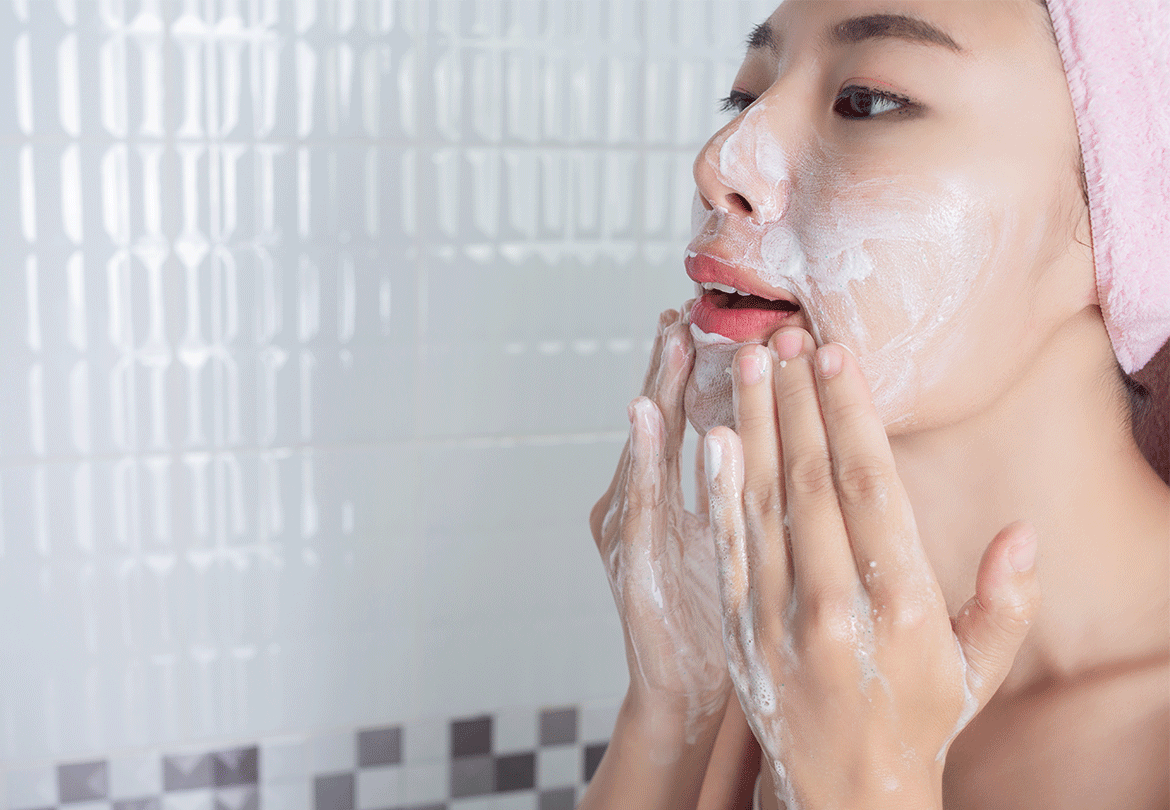Do you really cleanse your face properly?

It would seem like washing face is the simplest step of our skincare routine. Some people might just splash some water, apply a little cleanser on the face, and then rinse it off. However, adopting the appropriate cleansing way according to your skin type makes a huge difference between having healthy & supple skin and an acne breakout. This is because the elimination of oil, dirt, and undesirable debris allows your skin to unclog and enhance skincare product effectiveness with better penetration.
1. Washing hands before starting the whole skincare routine.
Before starting the whole washing process, it is vital to wash your hands thoroughly. Every day, we unconsciously touched numerous objects with our hands and the bacteria on our skin surfaces can lead to skin and eye irritation or infection.
An interesting fact - do you know that the typical mobile phone carries over 25,000 bacteria per square inch? This is 10 times dirtier than a toilet seat.

2. The first and most essential step of nighttime skincare routine even before washing face.
Shasa Hu, a board-certified dermatologist and co-founder of the skincare consultation service highly recommends making makeup removal the first step of the skincare routine. The minerals, chemicals, pigment, and preservatives can clog your skin pores and prevent penetration of skincare products (Business Insider Singapore, 2020).
Note: sunscreen and whitening cream also need to be removed before washing face.
3. How many times should I wash my face per day?
It depends on your skin type.
New York City-based dermatologist Hadley King (Business Insider Singapore, 2020) recommended as follows
Dry or sensitive skin types to cleanse once or more per day.
Oily skin requires to cleanse at least twice per day. (You might consider removing an excess amount of sebum with only water once per day and having deep cleanse with facial cleanser twice per day.)
Always washing after the workout and before bed as this helps to remove dirt and pollutants that accumulate on our skin during the day.
Cleanse your face in the morning if you have applied any overnight skin products.
4. Should I use any mechanical device to wash my face?
If your skin is sensitive, no cleansing device or brush is recommended to be used as this might further destroy your fragile skin barrier. You may use your fingertips to gently massage damp face in circular motions and this can be repeated more on your T-zone as it has a higher amount of oil glands.

Note: be careful with your fingernails while massaging face as they can scratch your skin, or the bacteria live under your fingernails can cause infection too.
Moreover, cleansing brushes can lead to oil build-up, said Hu (Business Insider Singapore, 2020). The cleansing devices might cause the skin to produce more sebum in response to aggressive mechanical exfoliation.
If your skin needs exfoliation, Hu recommended using a gentle exfoliating cleanser or a soft muslin cloth. Remember not to over-exfoliate as our skin has a natural protective barrier which helps us retain moisture (healthline).
5. What is sebum and why we should remove an excess amount of it?
Sebum is an oily, waxy substance produced by the body’s sebaceous glands. It benefits our skin by coating, moisturizing, and protecting skin surface. To be more specific, sebum contains fatty acids & triglycerides (57%), wax esters (26%), squalene (12%), and cholesterol (4.5%) (healthline).
For oily skin, the body may be producing an excess amount of the mixture of lipids (fat-like molecules) that make up sebum (healthline).
Sebaceous glands located at the majority of our body with the highest concentration at face and scalp. An excess amount of sebum can lead to clogged pores. Together with dead skin and bacteria, pimples will be formed on the surface of the skin pores.

Hence, while sebum is a necessary component of healthy skin as it locks in moisture, too much of it is problematic as well. The best situation for your skin will be achieving a water-oil balance by adjusting your skincare routine according to your skin type and condition.
6. Water temperature?
No scorching-hot water should be used to wash your face for all skin types, especially sensitive skin.
Warm water is recommended to help unclog the skin pores.
If your skin is hypersensitive, you might need to test if the water is too warm for your skin first before washing the face.
At the end of the face cleansing routine, cold water is recommended to calm the skin.
7. What should I use to dry my face after cleansing?
Facial tissue would be recommended as it is disposable and thus very hygienic.
The clean washcloth is also recommended if the cloth is not contaminated with bacteria and not too abrasive which might cause irritation (Business Insider Singapore, 2020).
Note: Gently pat and dry your skin without rubbing.
Quick Summary
1. Wash hands before starting skincare routine.
2. Remove make up is the first step even before washing face.
3. How often you should wash your face depends on your skin type.
4. Use fingertips to massage your face gently is more recommended than using mechanical devices.
5. Do not over-exfoliate your face skin.
6. Achieving water-oil balance is better than excessively removing sebum.
7. No scorching-hot water should be used to wash your face for all skin types.
8. Be aware of materials you use to dry your face after cleansing.
Remember to moisturize your skin and continue with the rest of the usual skincare routine.

Reference articles
https://www.businessinsider.sg/should-you-wash-your-face-in-the-shower-dermatologists-advise-2019-6
https://www.healthline.com/health/beauty-skin-care/face-washing-how-to#9
https://www.healthline.com/health/beauty-skin-care/sebum
Photo credits to
<a href="http://www.freepik.com">Designed by jcomp / Freepik</a>
<a href="http://www.freepik.com">Designed by pressfoto / Freepik</a>
<a href="http://www.freepik.com">Designed by macrovector / Freepik</a>
<a href="http://www.freepik.com">Designed by brgfx / Freepik</a>
<a href="http://www.freepik.com">Designed by macrovector / Freepik</a>



















